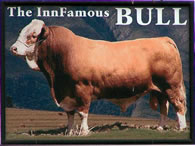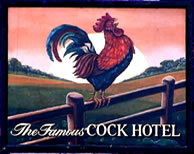LIFE ABROAD – Part 48-COCK & BULL
Posted on October 11th, 2013
Dr.Tilak Fernando
 The English phrase Cock and Bull relates to any fanciful and unbelievable tals or comic yarn. It was associated with travellers who met at two Public Houses during the 18th and early 19th centuries in England. During their overnight stay they concocted and exaggerated fanciful stories which have been finally branded as ‘cock and bull stories’.
The English phrase Cock and Bull relates to any fanciful and unbelievable tals or comic yarn. It was associated with travellers who met at two Public Houses during the 18th and early 19th centuries in England. During their overnight stay they concocted and exaggerated fanciful stories which have been finally branded as ‘cock and bull stories’.
Although there are several versions to the exact locations of the two public houses, it is learnt that the Pub named COCK was situated in Kilburn, North West of London and the BULL existed in High Gate, North London.
The following story is however not a ‘Cock and Bull Story’! The Pub COCK had been renovated before the Second World War, during which various parts of it had been preserved and later sold as -Ëœcollectors’ items to the public.
Lord Northcliff who owned No.13 Hyde Park Gardens (present Sri Lanka High Commission building) had bought a wrought iron radiator grill which had the name “COCK” ingrained at the bottom of it and used it to cover a hearth.
 Unknown to many, even to date, at the entrance of the High Commission adjacent to the main entrance door, the same old iron grill covers the central heating radiator. Although the grill has been painted over several times, the name COCK is visible to anyone looking at it carefully. Another important feature has been the underground tunnel that ran from the basement up to Baker Street where Lord Northcliff was believed to have used it as a ‘jogging’ track-â„¢ which has been blocked out now.
Unknown to many, even to date, at the entrance of the High Commission adjacent to the main entrance door, the same old iron grill covers the central heating radiator. Although the grill has been painted over several times, the name COCK is visible to anyone looking at it carefully. Another important feature has been the underground tunnel that ran from the basement up to Baker Street where Lord Northcliff was believed to have used it as a ‘jogging’ track-â„¢ which has been blocked out now.
History of High Commission
‚ Just prior to Ceylon became independent there existed an office known as The Ceylon House operating from 28 Cockspur Street, London SW1 where the chief of staff was known as The Ceylon Government Representative.
No.25 Grosvenor Square London W1 became the first official Ceylon High Commission with Sir Oliver Goonetilleke as the High Commissioner. On October 21, 1948 at the official inaugural ceremony King George VI, Queen Elizabeth and little Princess Margret participated at the ceremonial tea party. The special blue coloured China tea set especially bought to serve tea to the King had been preserved and was in display at 35 Avenue Road, ‘the official residence-â„¢ allocated for High Commissioners ‚ up until recently. Finally the lease at Grosvenor Square was sold to Americans for ‚£95,000 in 1950.
The Ceylon Government subsequently obtained a lease on ILCHESTER Estate, 21 Addison Road, in West London which consisted of five acres of land, massive garden, spacious basement, old war time bunker, swimming pool etc. A Scottish couple Mr. and Mrs. McBright served as caretakers.
Initially 21 Addison Road, London was used as The Ceylon Students’ Club until the Ceylon Students’ Centre was opened at No. 7 Clarendon Place London W2. The Government then planned to refurbish 21 Addison Road building and convert it into a High Commissioner’s residence which took nearly one year to complete. In the meanwhile, Sir Oliver and his skeleton staff moved to a 24 room mansion (The Long White Cloud) in a stud farm called Wear Bank in Bray, Hemel Hampstead, which belonged to Sir Oliver’s friend Dorathy Sandauers.
Hyde Park Gardens
‚ After the 2nd world war, buildings at Hyde Park Gardens were barely empty and the whole terrace of houses belonged to the Church Commissioners; Chestertons managed their properties.
Ceylon government managed to purchase a renewable lease initially for ‚£14,000 and moved the Sri Lanka High Commission to 13 Hyde Park Gardens, which was the largest building along the whole terrace of houses there. The lease was extended later for a sum of ‚£ 45,000 with a ground rent of only ‚£500 per annum.
In the meanwhile some grandiose ideas emerged to convert 21, Addison Road premises into a Sri Lanka complex where all the government Institutions based in London to be housed under one roof. With this in view many blue prints were on the drawing board and PWD Engineers and Architects arrived from Colombo and building plans were made available when the lease expired and the whole operation looked like ‘building castles in the air’!
During Dr. M.V.P. Pieris’ tenure in London as the High Commissioner, the Government managed to purchase its first Free Hold property at 35 Avenue Road, St. John’s Wood, London NW8 for a sum of ‚£ 375,000 in 1970 from one Mrs. Green. It contained an old building aged about 150 years with a three bedroom cottage used by Mrs. Green’s Gardner. The extent of the land was approx one acre.
The old house was converted and used as the official High Commissioner’s residence where Dr. M.V.P Peiris, V.L.B. Mendis, A.T. Moorthy, C. Monerawela, Tilak Gooneratne, S.K. Wickremasinghe, Lal Jayawardena, General Sepala Attygalle, General Cyril Ranatune, Mangala Moonasinghe, Faiz Mustapah and Kshenuka Seneviratne occupied as subsequent High Commissioners.
13 Hyde Park Gardens basement was converted into flats during President Premadasa’s term of office. This being the biggest building along the whole of the terrace many were eyeing the place including some rich Saudi Royal members. Affluent neighbours around were not very much in favour of the idea of Sri Lanka High Commission standing in their midst; this perhaps resulted in Chestertons to approach the Sri Lanka government with a tempting offer to buy back the remaining unexpired lease of approximately 30 years for a tidy sum of one million pound sterling (‚£1,000,000). This took place during the period Guy Amirthanayagam was acting as the High Commissioner for Tilak Gooneratne, who was at the time in Sri Lanka on medical leave (during 1981-1982).
The offer inspired Guy Amirthanayagam. Being in good books of Mrs. Bandaranaike he approached her to agree to Chestertons proposal where they (Chestertons) had come out with a bonus offer of constructing a brand new building at 35 Avenue Road for a sum of ‚£ 300,000 and to do all supervisory work on the new construction completely free of charge!
Mrs. Bandaranaike considered the project seriously as a viable proposition and agreed in principle. Subsequently preparations were done to construct the new building at Avenue Road with a touch of ‘Kandyan architecture’.
However, after Amirthanayagam left London, the late V.L.B. Mendes took over as the new High Commissioner and managed to reverse Mrs. Bandaranaike’s decision, the result of which was that the sale never went through and the old 150 year old building was used continuously as the High Commissioners residence and the three bedroom Gardner’s cottage was converted into staff quarters where a first secretary was accommodated there.
Whatever the reasons behind for change of plan (Political, personal or otherwise) High Commissioner Mendis’s decision had begun to have severe consequences on the Sri Lankan Government expenditure in having to refurbish the dilapidated building at an exorbitant cost which had been allowed to deteriorate without any regular repairs or maintenance and become ‘inhabitable’.
When the new High Commissioner Kshenuka Seneviratne occupied the residence, Avenue Road building had ‘reportedly’ deteriorated to such an extent that she had to find alternative accommodation at an extra cost to the Foreign Office budget.
Several reports from professional civil engineers and chartered quantity surveyors then followed with recommendations to sell the property highlighting the cost of major repairs as exorbitant, unaffordable and meaningless.
The situation created a hullaballoo and soon No. 35 Avenue Road turned into a highly blown up controversy in London and a hot potato within the Foreign Ministry; many protests against the disposal of the property appeared in Sri Lankan news papers etc.
Finally it was reported in the Sri Lankan press that when the news reached President Mahinda Rajapaksa’s ears, he made a final and irreversible decision that ‘no Sri Lankan property in England should be sold or disposed of’.
The general overall tittle tattle among the Sri Lankan Diaspora in the UK on this issue has been that, “a sensible proposal overridden once by another senseless ambassadorial decision has been able to create a big hole in the foreign office budget, which obviously has made a boo boo of the whole thing“!
As a feed back to what I have written about Sir John Kotelawela in my last week’s column on Dixon Kotelawala, my good friend Merril has added a bit more humour to it as follows:
“Sir John’s reply to ‘fly by night’ (Tarzie) nearly came out in the British press. I hear that the High Commissioner at the time Sir Claude Corea (if I’m correct) had to plead with the British Press to prevent it being given any publicity.”
“Sir John’s confidante was J.L Fernando, one time the chief editorial executive of the Daily News.
” One day JL having spotted a French Book in Sir John’s library had borrowed it, when he returned the book he had sent a courteous ‘Thank you’ note written in French .
Sir John’s reply had been:
“My dear J.L, Thank you for your French letter”.
That was Sir John.
